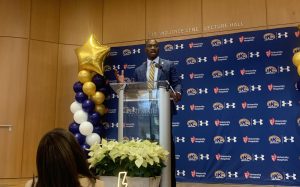How to earn a stylish masters
September 18, 2010
Fashion school launches first graduate concentration
Three years after receiving her diploma, Kristen Medcalf found herself in the classroom once again, this time as a pioneer graduate student.
“You do get comfortable after graduation not having to go to class and things like that,” Medcalf, a fashion concentration graduate student, said, “but I think if you’re focused on what you want and that’s a goal for you, then coming back is really just second nature.”
Medcalf is one of seven students enrolled this semester in the fashion school’s first graduate program, a combined effort with the business school to offer students a Master of Business Administration degree with a fashion concentration.
“When you look at Target and how well designed even their kitchen tools are, design management has become so important today because we have all the stuff we ever could need,” Nancy Stanforth, fashion school professor, said. “Now we pick things because we need them and love them, and that’s where this whole concept comes from.”
Realizing its importance not only in the business world, but also on a personal level, Emily Dolata scooped up this graduate opportunity after surpassing the required 90 credit hours and 3.3 GPA.
“This is the biggest thing: I actually could do it,” Dolata said. “A lot of people have a connotation of fashion majors that they aren’t smart or they can’t get their MBA, and we are obviously a minority in the graduate classes too. So I think that this program is good because we’ll steadily get more people from the fashion program to continue on.”
Not all students choose to enroll directly in a master’s program upon graduation, though. Some, like Medcalf, take time off to work in the industry, a decision that boasts its own benefits. Louise Ditchey, academic program director for the Graduate School of Management, said many people find it easier to apply what they have learned to true life experiences.
“When you are studying these things in a vacuum, you don’t have a lot of experience to tie it to,” Ditchey said. “If they can tie it to something they’ve learned or heard from other students who’ve experienced it on the job themselves, it tends to have more significance.”
While this student-centered program belongs to the business school, Stanforth said she is hoping a larger, in-house track can eventually exist in the fashion school. Only the four fashion-concentrated electives are offered there: design management, design theory, research methods and individual thesis writing.
“Students are getting something incredibly valuable from this program,” Stanforth said. “It’s just giving them that little bit of business sense that they can turn into a really fabulous career. I have seven in this very first class, but we hope for 15 to 20 eventually, once people get into the cycle of the program.”
The possibility of a “fabulous career” is already in the works for those seven students. Dolata, optimistic for the future, said she is excited to be a part of the fashion concentration’s pilot semester.
“In the graduate classes, it’s more real-world application,” Dolata said. “It’s kind of exciting for Kent because when we met about two weeks ago for class, that was the first graduate fashion class they’ve had here. I think it’s exciting to be the first person to go through and really do it.”
Contact Emily Inverso at [email protected].












